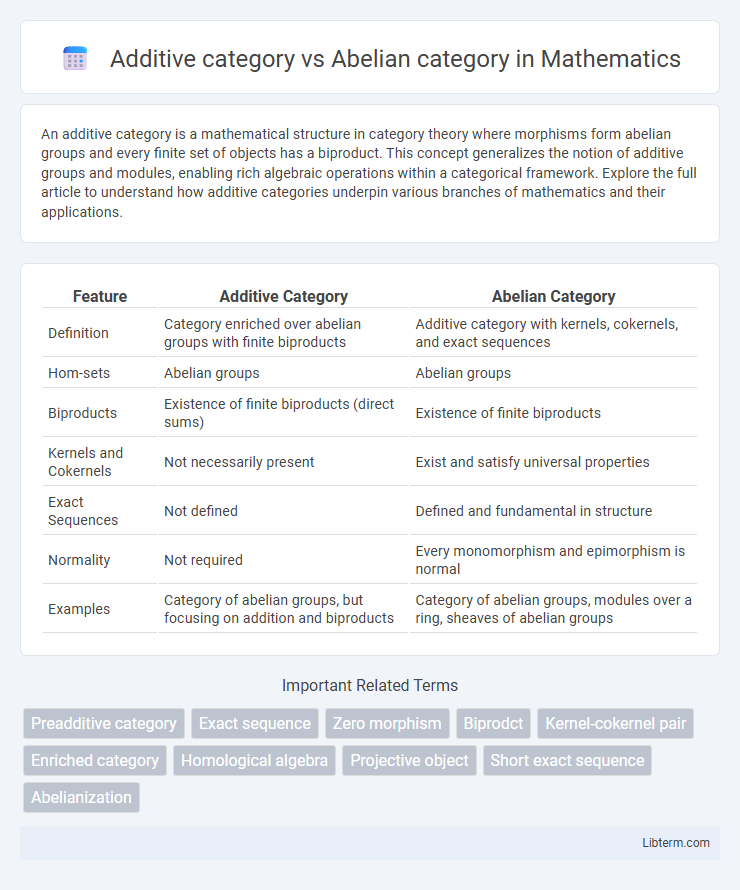An additive category is a mathematical structure in category theory where morphisms form abelian groups and every finite set of objects has a biproduct. This concept generalizes the notion of additive groups and modules, enabling rich algebraic operations within a categorical framework. Explore the full article to understand how additive categories underpin various branches of mathematics and their applications.
Table of Comparison
| Feature | Additive Category | Abelian Category |
|---|---|---|
| Definition | Category enriched over abelian groups with finite biproducts | Additive category with kernels, cokernels, and exact sequences |
| Hom-sets | Abelian groups | Abelian groups |
| Biproducts | Existence of finite biproducts (direct sums) | Existence of finite biproducts |
| Kernels and Cokernels | Not necessarily present | Exist and satisfy universal properties |
| Exact Sequences | Not defined | Defined and fundamental in structure |
| Normality | Not required | Every monomorphism and epimorphism is normal |
| Examples | Category of abelian groups, but focusing on addition and biproducts | Category of abelian groups, modules over a ring, sheaves of abelian groups |
Introduction to Category Theory
Additive categories are enriched over abelian groups, featuring zero objects and biproducts that combine product and coproduct structures. Abelian categories extend additive categories by ensuring every morphism has a kernel and cokernel, and that all monomorphisms and epimorphisms are normal, enabling exact sequence formulations. These structures form foundational frameworks in category theory for homological algebra and representation theory.
Understanding Additive Categories
Additive categories are enriched over the category of abelian groups, meaning each hom-set carries an abelian group structure compatible with composition, enabling direct sums and zero objects. They provide a foundation for constructing more structured categories, such as Abelian categories, where kernels and cokernels exist and every monomorphism and epimorphism is normal. Understanding additive categories clarifies the algebraic framework necessary for homological algebra and exact sequence analysis.
Key Features of Additive Categories
Additive categories are characterized by having a zero object, binary biproducts, and hom-sets equipped with abelian group structures where composition is bilinear. They allow direct sums of objects and ensure that morphisms form additive groups, facilitating the manipulation of objects and morphisms using algebraic operations. Unlike abelian categories, additive categories do not necessarily require kernels and cokernels to exist or agree, making them a broader framework in category theory.
Defining Abelian Categories
Abelian categories are additive categories enriched with kernels and cokernels, where every monomorphism and epimorphism is normal, ensuring exactness properties analogous to those found in module categories. They support the construction of exact sequences, making them fundamental in homological algebra and allowing morphisms to factor through images and coimages. Unlike general additive categories, abelian categories guarantee the existence of all finite limits and colimits, providing a robust framework for algebraic structures.
Essential Properties of Abelian Categories
Abelian categories are additive categories endowed with kernels and cokernels for every morphism, ensuring that all monomorphisms and epimorphisms are normal. They exhibit exactness properties such as every morphism factoring uniquely into an epimorphism followed by a monomorphism, enabling the development of homological algebra. The essential properties include the existence of finite biproducts, exact sequences, and the ability to form quotients and subobjects with well-behaved kernels and cokernels, distinguishing them from general additive categories.
Additive vs Abelian Category: The Core Differences
Additive categories are characterized by having a zero object, finite biproducts, and morphism sets forming abelian groups, enabling addition of morphisms. Abelian categories extend additive categories by requiring kernels and cokernels to exist for every morphism and insisting that every monomorphism and epimorphism is normal, ensuring exactness properties. The core difference lies in abelian categories' richer structure supporting exact sequences and homological algebra, while additive categories provide a more general framework focused on morphism addition and biproducts.
Morphisms and Exactness in Both Categories
Additive categories feature morphisms forming abelian groups, enabling addition and zero morphisms, but lack guaranteed kernels and cokernels necessary for exactness. Abelian categories extend additive categories by ensuring every morphism has a kernel and cokernel, allowing the definition of exact sequences integral for homological algebra. Exactness in abelian categories implies precise control over images and coimages of morphisms, facilitating advanced notions like exact functors and derived categories, which are generally absent in additive categories.
Examples of Additive and Abelian Categories
Additive categories include examples such as the category of abelian groups, which has direct sums and zero objects but may lack kernels or cokernels. Abelian categories, a special class of additive categories, encompass categories like the category of modules over a ring and the category of coherent sheaves on a scheme, where every morphism has a kernel and cokernel, enabling exact sequences. The difference is highlighted by additive categories that may not support exact sequences, whereas abelian categories fully support homological algebra structures.
Significance in Algebra and Homological Algebra
Additive categories provide a foundational framework for algebraic structures by allowing morphisms to form abelian groups and supporting biproducts, essential for linear algebra and module theory. Abelian categories extend this structure by ensuring the existence of kernels and cokernels, enabling exact sequences and homological constructions critical for derived functors and cohomology theories. The significance in homological algebra lies in abelian categories serving as the ideal setting for defining and analyzing homology and cohomology, while additive categories underpin simpler additive structures without necessarily supporting exactness properties.
Conclusion: Choosing Between Additive and Abelian Categories
Additive categories provide a flexible framework with direct sums and zero objects, ideal for contexts where kernels and cokernels are not required. Abelian categories extend additive categories by guaranteeing exact sequences, enabling robust homological algebra and module theory applications. The choice depends on whether the mathematical framework demands the structural richness of exactness and abelian properties or the more general, less restrictive setting of additive categories.
Additive category Infographic

 libterm.com
libterm.com